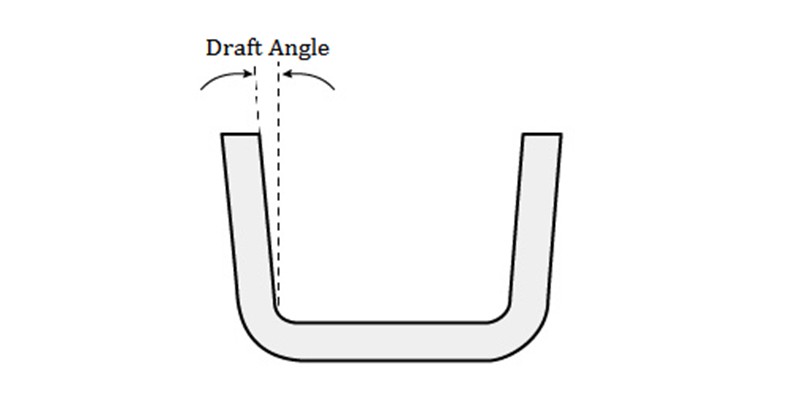- November 18, 2022
Injection molding is one of the most popular methods for rapid manufacturing. The injection molding draft angle is a critical parameter in this process that has a significant impact on product quality.
In this article, our discussion will focus on draft angle injection molding. We will explain what is draft angle, why it is important, and what things you should keep in mind while designing molds for injection molding.
What is Draft Angle in Injection Molding?
The injection molding draft angle is an essential geometric feature built into molds for injection molding. It is the taper, or degree of inclination, of the mold’s walls along the drawing direction.
As it is a feature of the mold, the draft angle is also visible on the component. Its unit of measurement is degrees.
Typically, engineers use an angle of around 1.5 degrees. However, it can range anywhere between 0.5-10 degrees for certain special applications.
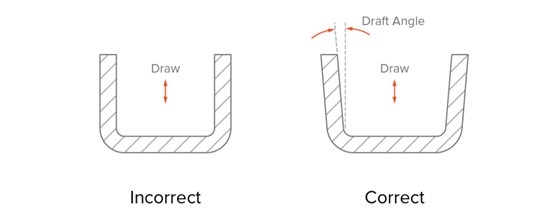
Why Draft Angle is Important in Injection Molding?
It is easy to grasp the concept of what is the draft angle. Its benefits, however, are not as intuitive to understand and require some discussion. It is the most important among all molding angles. Small miscalculations can ruin the entire product line and even damage the injection molding equipment.
Without further ado, let us dive into the various reasons that make it an important injection molding parameter.
Smooth Part Ejection
Part ejection is a crucial step in the molding process and a major reason for having the injection molding draft angle. Right before part ejection, the part is in contact with the walls of the mold. The contact stresses are high enough to deform the part from friction during ejection.
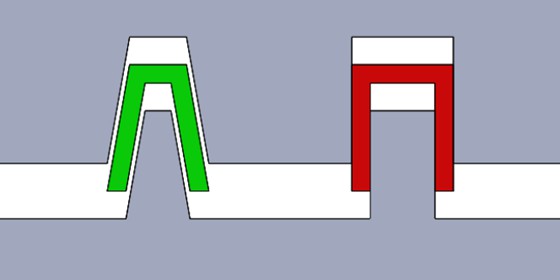
Therefore, it is desirable to minimize the impact of this frictional force. Engineers do this by including a draft in the mold. As soon as the part is pushed outwards by the ejector pins, the entire part pops out and loses contact with the mold walls. This lack of contact translates to no friction.
Without the draft angle, the part would rub against the surface of the mold throughout the ejection process, as seen in the figure. This is highly detrimental to the surface finish and manufacturing tolerance.
Moreover, the lack of friction also decreases the required ejection force, positively impacting the power requirements and also speeding up the ejection process.
Warping
Warping is one of the serious defects in injection molding processes. To explain what it is, refer to the figure in the previous section showing parts with and without draft angles.
When there is no draft angle by design, a vacuum might form in the empty space that appears when the part is ejecting. This vacuum causes the part to fold in on itself. This undesirable deformation is warping.
As can be seen, this issue is not present with an injection molding draft angle. As soon as the ejection process begins, the part separates from the mold and creates room for air to fill all cavities, preventing the vacuum from forming. Therefore, no warping occurs.
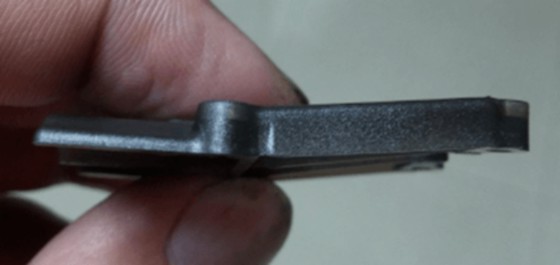
Surface Finish
We briefly touched upon this advantage of draft angle injection molding in the previous section. Due to the draft, the part does not rub against the mold, which preserves the surface quality.
An important consideration here is the variation of the draft angle with the surface texture requirements. The draft angle needs to accommodate surface texture features as well in addition to the gross geometric features of the component.
This means that all craters/protrusions that make up the surface texture should also get enough space to detach from the mold wall. We will discuss more of this very soon.
Reduces Deep Draw
The mold halves separate along the line of draw. This line of the draw is strategically placed to tackle critical errors such as deep drawing and flash.
In the case of a deep draw, the issue of the part getting stuck inside and to the mold is dealt with. The injection molding draft angle helps to reduce the negative effects of a deep draw, with a larger draft angle decreasing the risks.
Manufacturing Costs
Molding angles have a huge effect on injection mold costs. From the above discussion, we can deduce numerous ways the injection molding draft angle helps cut costs.
First of all, molds with draft angles produce parts with a better surface, less warping, and deep drawing issues. As a result, manufacturers incur fewer costs in part finishing and failed parts.
Additionally, maintenance costs are also much lower due to draft angles. The aforementioned friction damages the mold as well, which requires regular polishing and even replacement due to wear and tear.
Finally, the draft angle also saves costs by making the injection molding process quicker. It leads to quicker cooling cycles and part ejection.
Design Guidelines for Draft Angle in Injection Molding
The injection molding draft angle is a sensitive parameter that requires fine-tuning by mold designers. In this section, we present a list of recommendations for choosing the correct draft angle for specific applications.
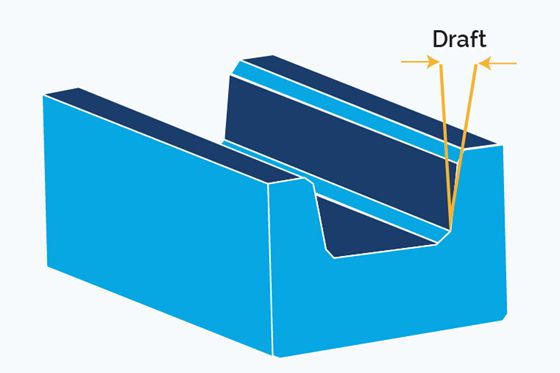
Mechanical Fits and Thermal Shrinkage
The draft angle injection molding alters the thermal shrinkage of the molten resin/metal during the cooling cycle. This is because the shrinkage depends on the part geometry.
Shrinkage is always towards the geometry’s center of mass. This means that the outer faces of the part shrink away from the mold and separate from the walls while internal faces shrink inwards, onto the mold, gripping it tighter. As a result, the geometric dimensions of the part can change and affect its ability to form appropriate mechanical fits during assembly.
So, designers must take care that the draft angles included in their designs must not violate dimensional tolerances after shrinking. This specifically applies to all components and faces that are part of a mechanical fit.
Higher Draft for Coarse Textures
We discussed the link between textures and injection molding draft angle before. The draft angle should create enough space so that the texture does not scrape off during ejection.
The rule is that the rougher the texture gets, the higher should the draft angle be. This assists in part ejection and preserving the quality of the texture.
Generally, for a mirror finish, a draft angle of 0.5 degrees will be appropriate. However, for every 0.1 mm increase in surface roughness, the draft angle should increase by 0.4 degrees. For exceptionally coarse patterns, engineers can opt for extreme draft angles up to 10 degrees as well.
Higher Draft for Deeper Features
The deeper the vertical features of the component get, the more prone it becomes to warping. Deeper parts have more empty spaces for vacuum generation during ejection. Thus, they warp more intensely, and more quickly.
The solution is quite straightforward – increase the injection molding draft angle for deeper features. The general rule of thumb is to add an additional degree of the draft for every inch in part depth. This rule may change slightly with part size and material but generally applies to the majority of injection molding jobs.
This is a highly efficient method for tackling components with features like deep pockets and cavities.
Core-Cavity Approach for Functionality and Aesthetics
The core cavity approach is a technique that applies to parts where the outer side should be smooth while the inner side may remain a bit rough. This requirement is oftentimes for aesthetic purposes. For example, in protective enclosures, the outer surface is smooth and shiny for looks. It may also be a functional requirement if the outer part needs to slide or the inner part assembles with other components.
Either way, in the core cavity method, the injection molding draft angle is slightly higher for the core so when the part shrinks, it shrinks into itself. In other words, its internal part sticks to the mold while the outer part completely detaches from the walls.
This way, the surface finish of the outer faces remains undamaged at the expense of higher roughness on the inner faces.
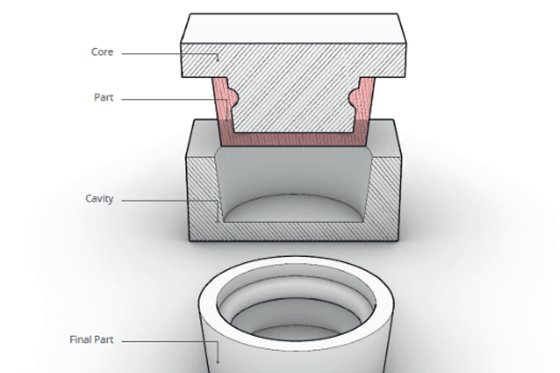
Quick View: Tips and Tricks for Determining Draft Angle
It can be a bit difficult to absorb so much information about molding angles in one sitting. To help our readers, here is a comprehensive list of tips and tricks:
- An injection molding draft angle of 1.5 degrees is recommended for general injection molding jobs.
- Incorporate the draft angles in both the cavity and core, with a slightly larger draft angle for the core.
- Add 1 degree of the draft for every inch increase in part depth. The depth, of course, means the dimension along the direction of the drawing.
- Smooth surface textures require a small draft and rough textures require a high draft. Increase the draft by 0.4 degrees for every 0.1 mm increase in surface roughness.
- Add draft angles to all vertical features like walls, ribs, louvers, undercuts, etc.
- Use the core cavity approach if the outer face of the component needs to be smooth.
- If the component has features that require side drawing (additional drawing direction), include drafts in those features too.
- Hard materials with abrasive qualities warrant higher draft angles than soft, ductile materials.
Conclusion
This concludes our discussion on the questions of what is the draft angle, why it is beneficial, and what should you know about it. We hope that it was an interesting read and oriented your knowledge as injection molding designers. Are you have an injection molding project?
WayKen Rapid Manufacturing is an industrial expert in injection molding. Our rapid tooling services include exceptional mold designing and manufacturing, including highly accurate simulations and precise machining of molding angles. We provide a complete one-stop tooling solution with our advanced technologies, cost-effective manufacturing, and professional management.
We also provide extensive support to our clients right from the start. With our free-of-cost Design for Manufacturing (DFM) analyses, you can optimize your tooling designs before moving ahead with production. Today we invite you to contact us with your injection molding and tooling projects!
FAQs
When to include a draft angle in the design process?
While the draft angle is strictly a requirement for flawless manufacturing, it affects part functionality. Hence, it is suggested to consider including the draft angle right at the beginning of the design process i.e. preliminary designing and prototype building.
Can I avoid draft angles?
It is not advisable to neglect draft angles in most cases due to the serious repercussions. It is an essential part of the manufacturing phase and affects the quality of production. In certain conditions such as the part being very small or tolerances being very low, a designer may choose to avoid draft angles, but even then it is not recommended.
What are positive drafts and negative drafts?
A positive draft angle is when the drafted features ‘taper in’ inside of the mold. That is, the features are wider at the base and narrower inside of the mold. A negative angle is the opposite of this. It ‘tapers outwards’ inside the mold.

